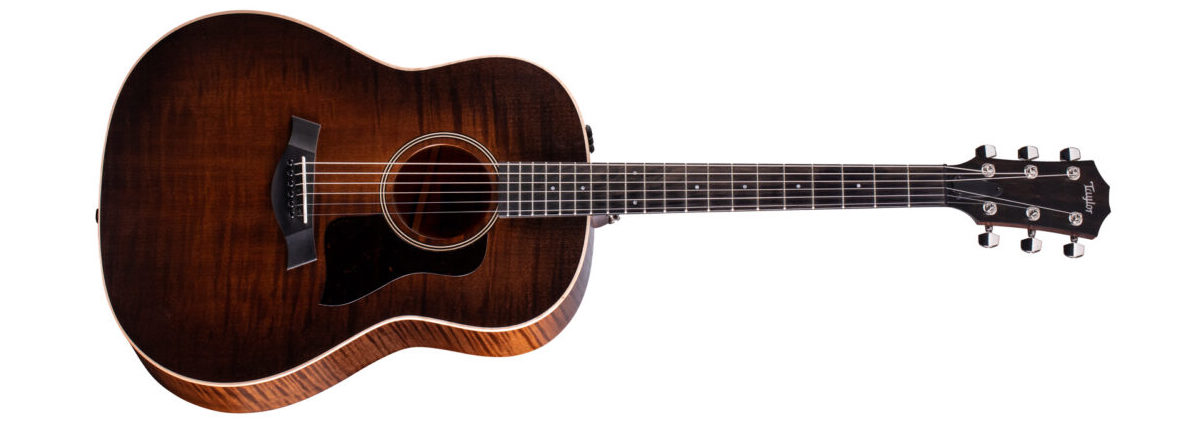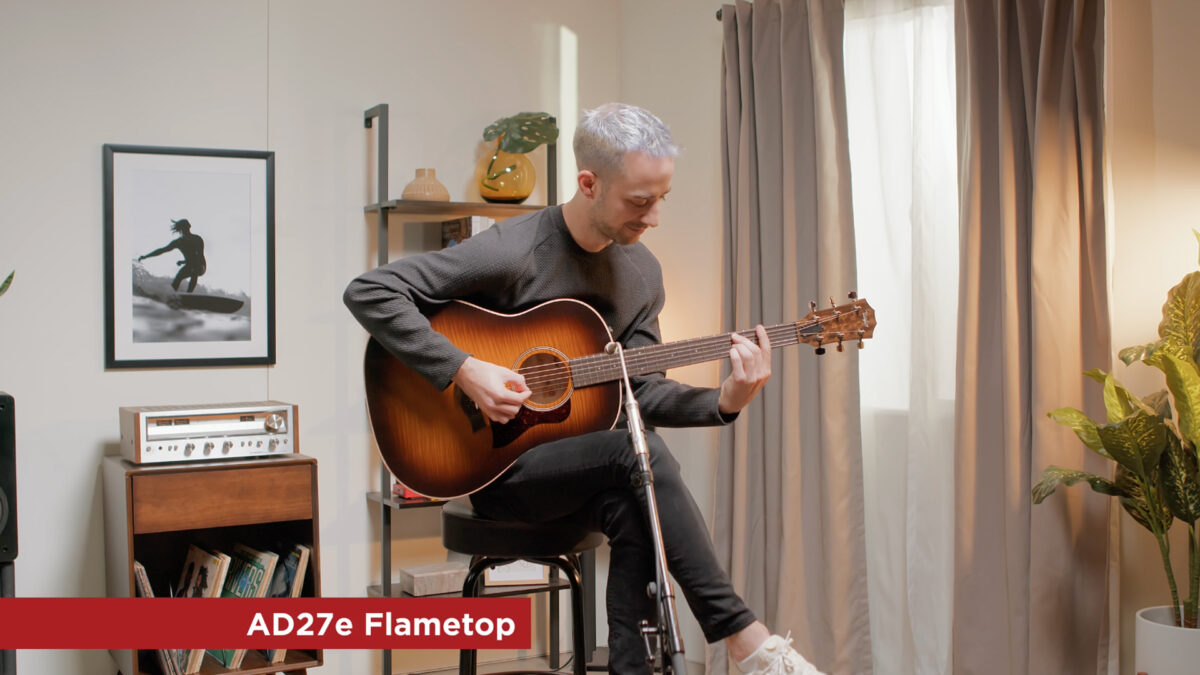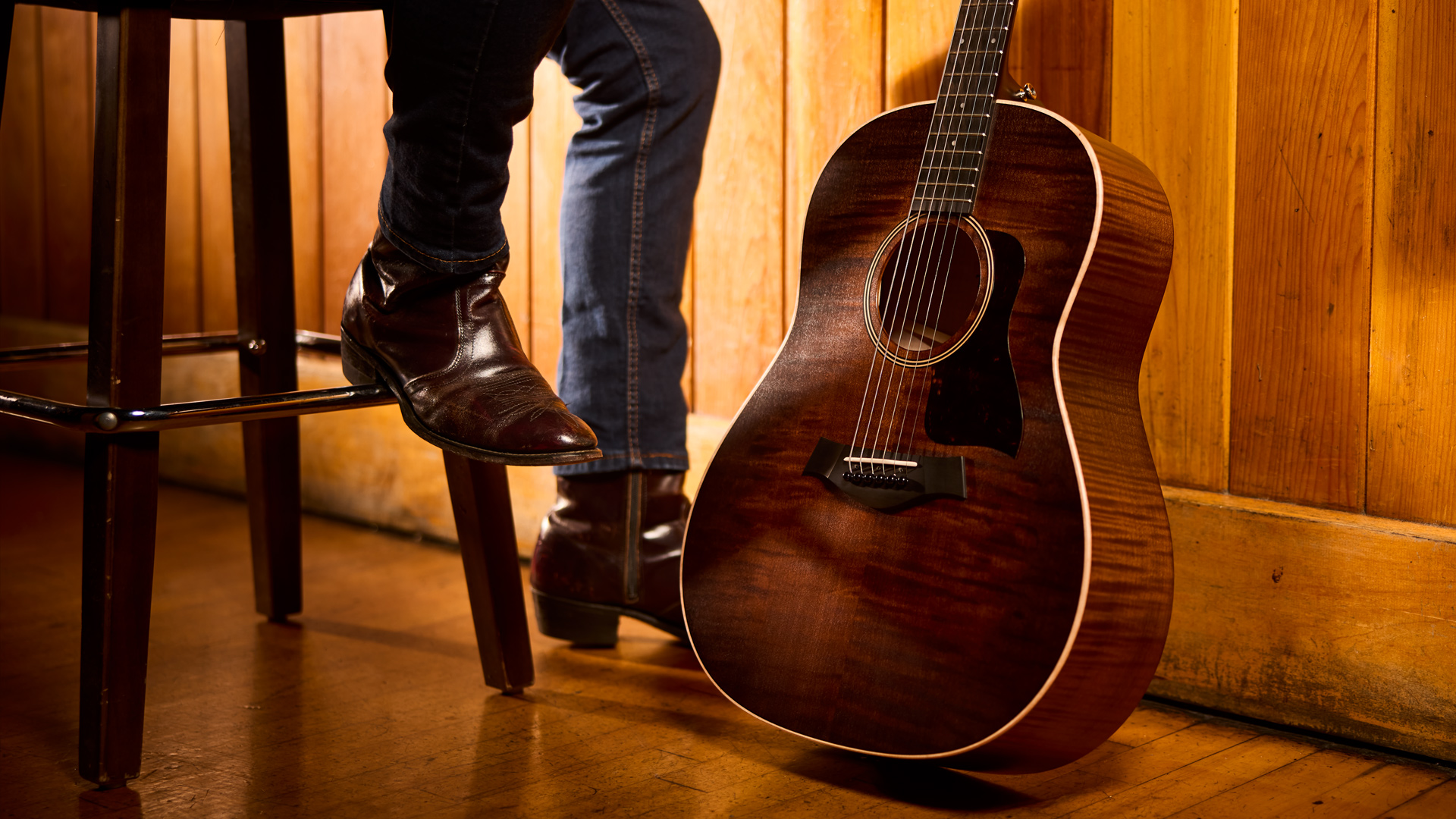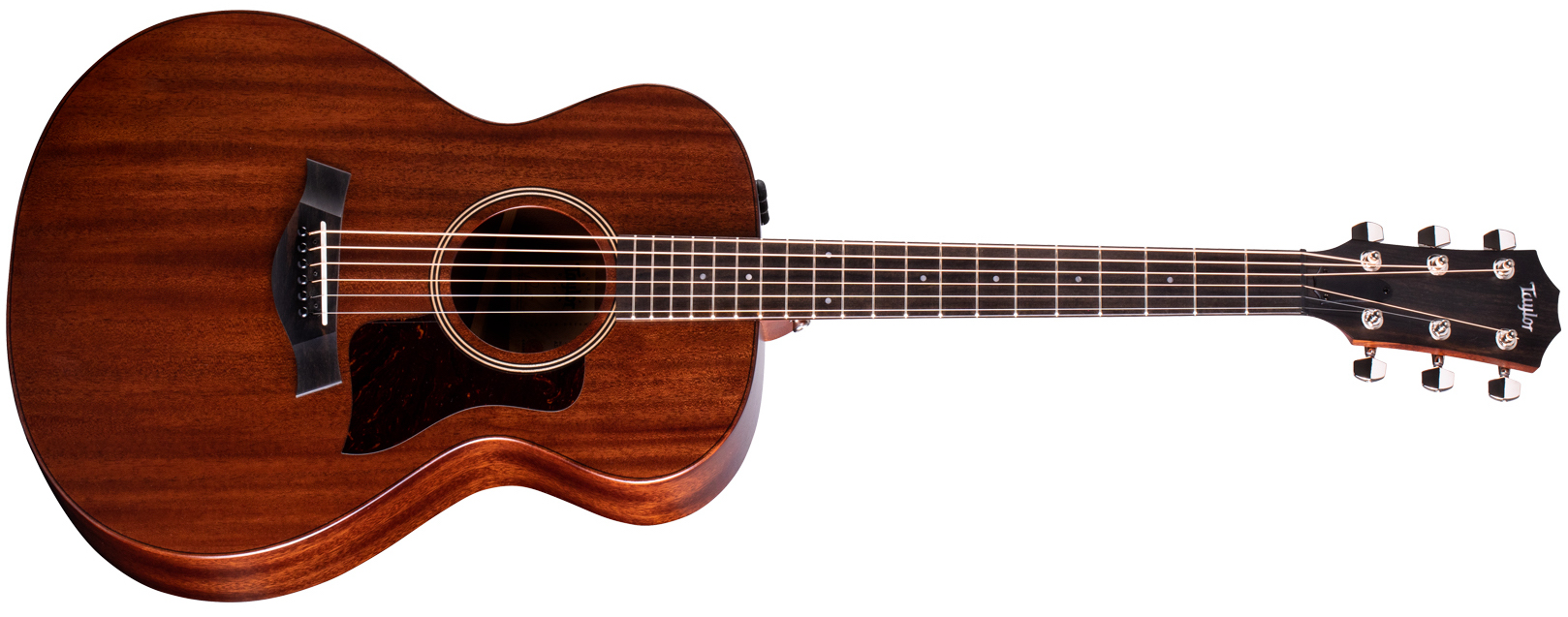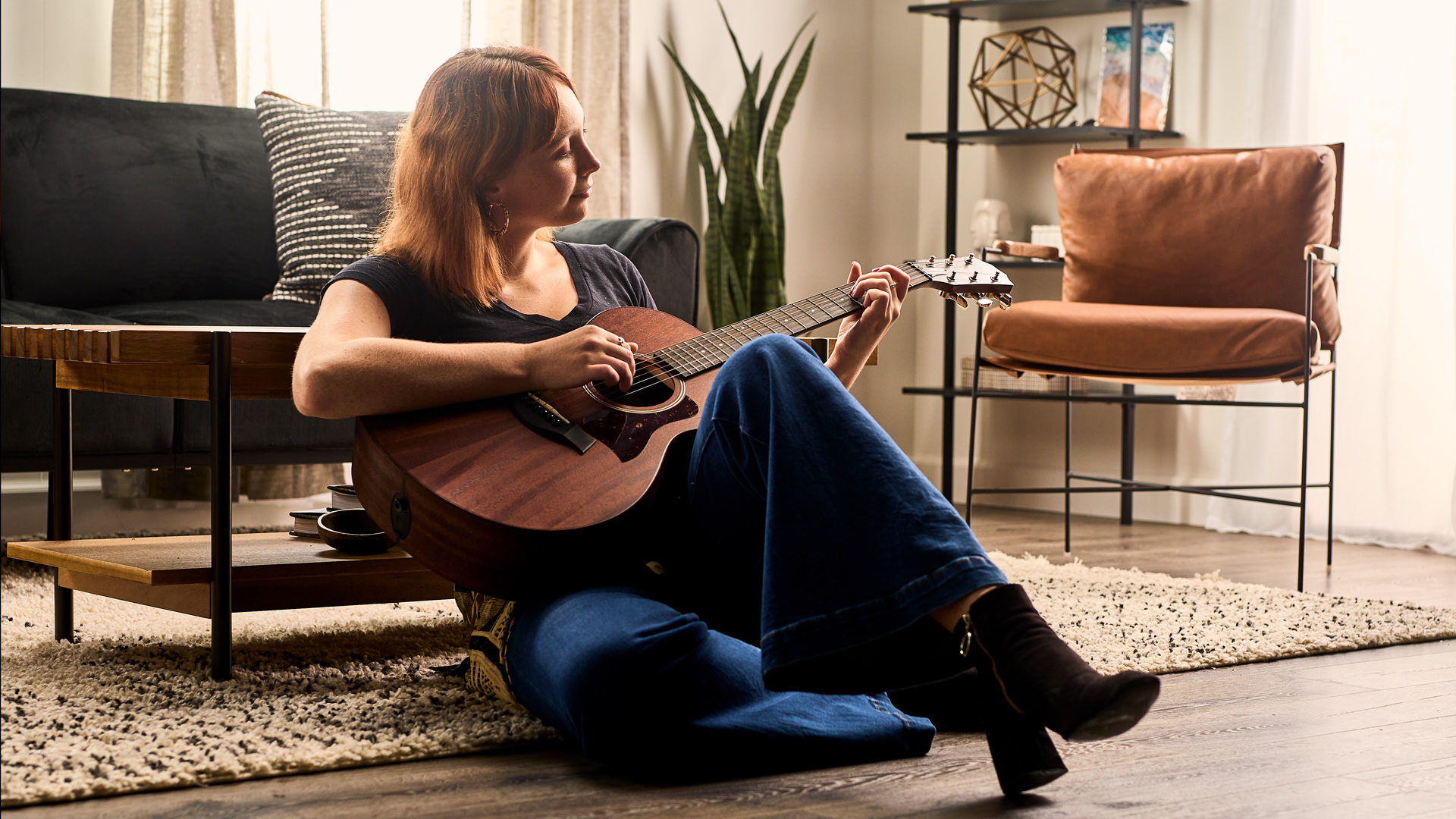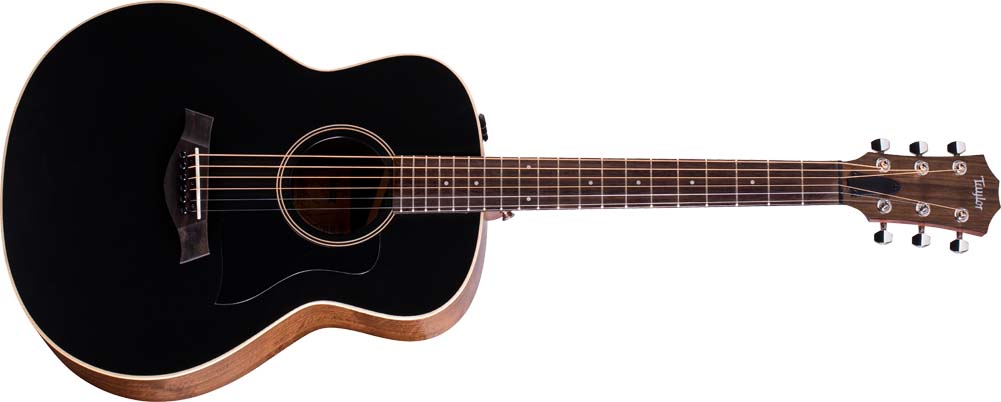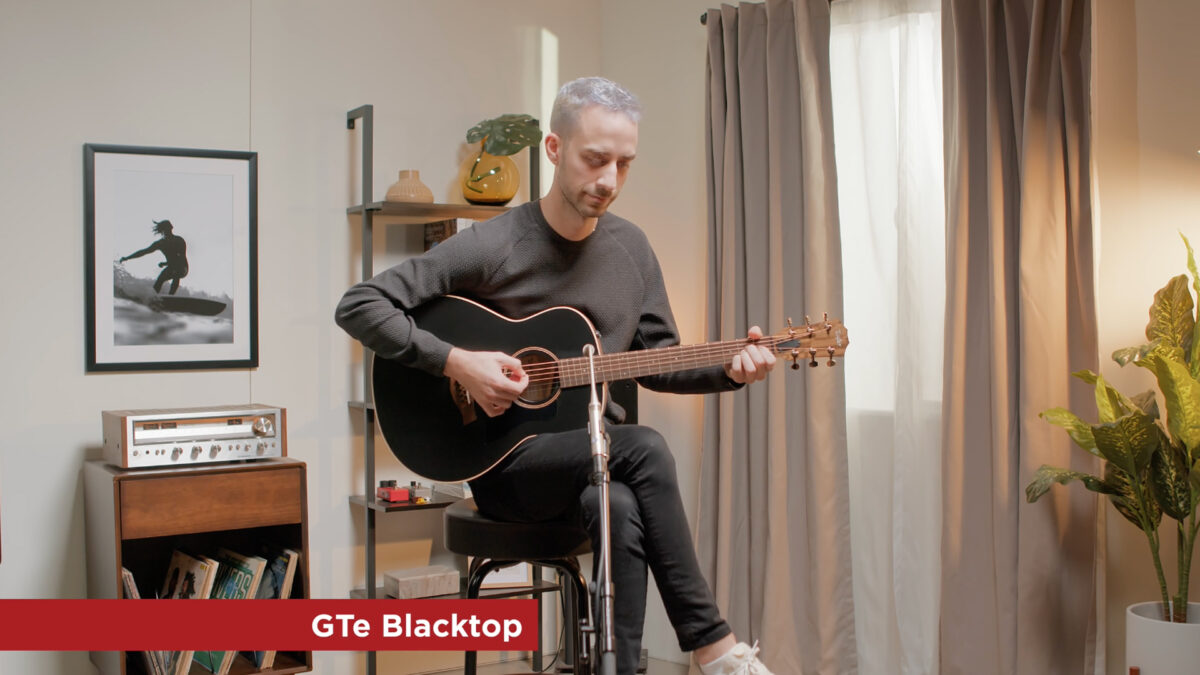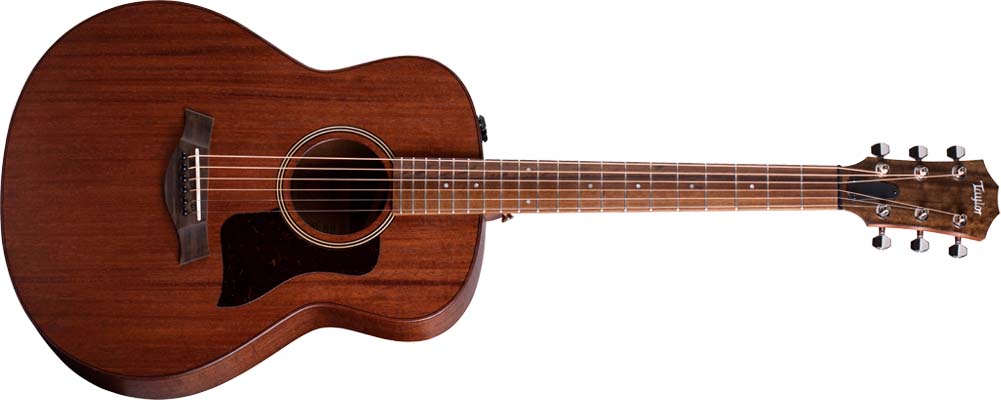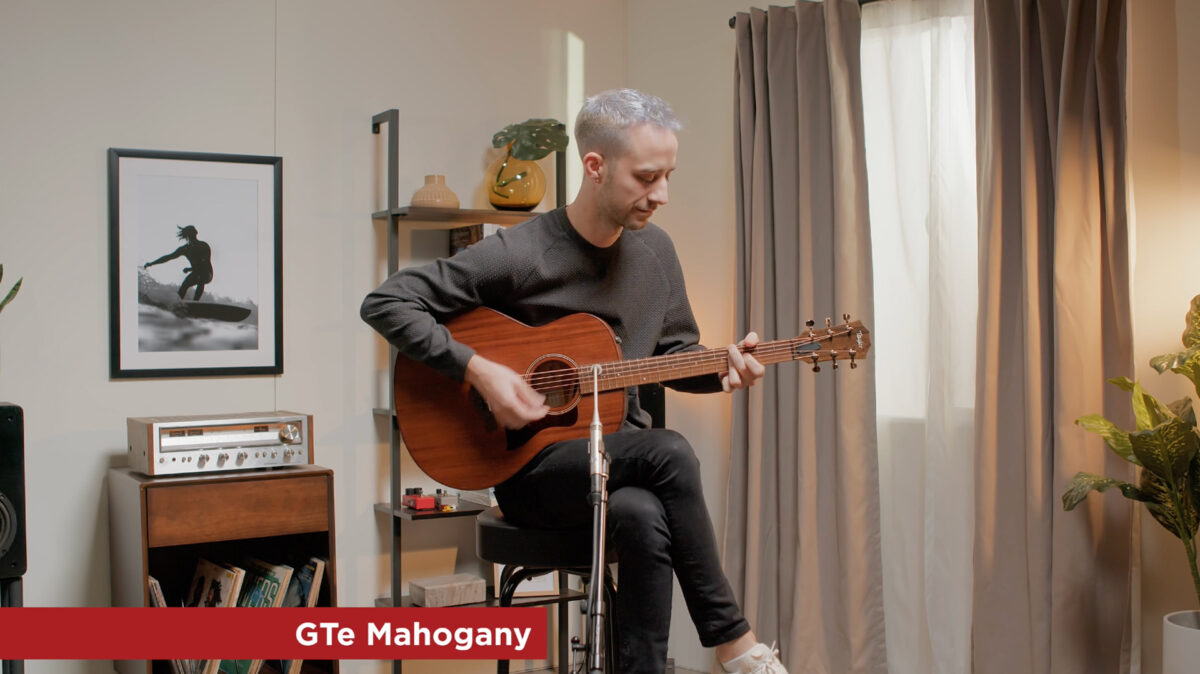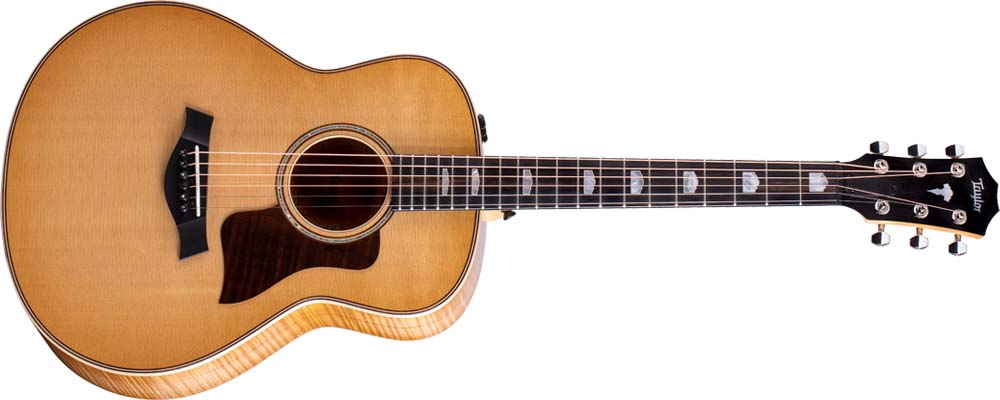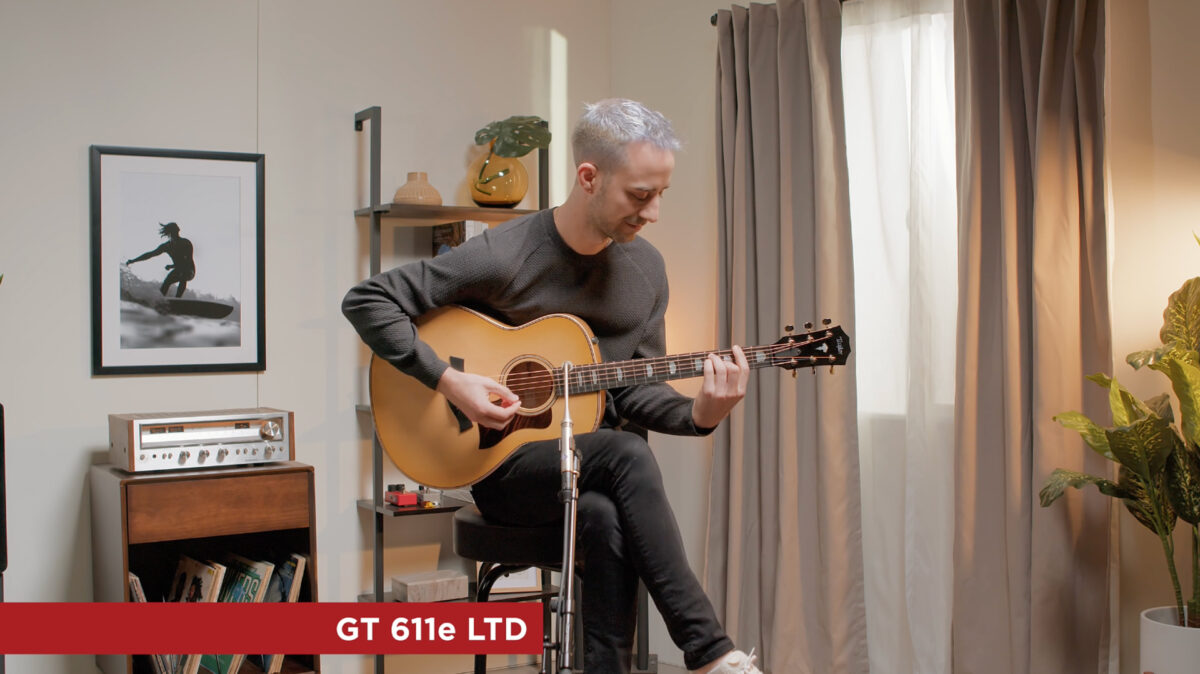When we unveiled our V-Class® bracing architecture back in 2018, our messaging around the launch staked a bold claim: V-Class was “a groundbreaking new sonic engine,” a “game changer” that promised to “reframe the future of Taylor acoustic tone.” While the language might have seemed like a marketing flex, we believed it; we’d played the V-Class guitars during development, and to us the difference was real.
Artists, recording engineers and reviewers agreed, picking up on its fundamental tonal improvements: greater tonal output, sustain and harmonic agreement, or “in-tuneness,” between notes along the entire fretboard. In simpler terms, it made our guitars sound better. To critics and players, including many of you reading this who own V-Class guitars, V-Class was legit.
But the bigger promise of V-Class lay ahead. Master builder Andy Powers saw it as a liberating platform that not only enhanced the musicality of our guitars but would also enable him to voice individual models in ways that gave each a more distinctive musical personality. Ultimately, it would create a much more diverse palette of acoustic sounds for players to explore.
The ensuing four years have paid sweet sonic dividends and brought a steady transformation of the Taylor line. In addition to adapting V-Class to existing Taylor models, Andy used V-Class to voice a new body style, the Grand Pacific, a round-shoulder dreadnought that diverged from the tone profile associated with our flagship Grand Auditorium. Where the GA’s overall sound was more “modern” — clear and vibrant, with well-defined notes — the GP’s sound leaned more toward traditional dreadnought tone — a warm, seasoned voice, with notes that were broader in shape and blended into each other. V-Class also enabled the GP to produce clearer low-end power, cleaning up the muddiness that often plagued classic dreadnoughts in recording studios or live settings.
V-Class also inspired Andy to create our premium Builder’s Edition class of guitars. These instruments matched model-specific V-Class voicing with comfort-forward contouring refinements to enhance the feel and enable players to express themselves more freely. Builder’s Edition has since grown into a robust collection of nine distinctive models.
Then came the Grand Theater, or GT, which not only debuted a new body style but a new category of guitar, featuring a scale length (24-1/8 inches) that was shorter than our Grand Concert (24-7/8 inches). This time, Andy adapted his V-Class ideas for the guitar’s unique proportions and created C-Class™ bracing, an asymmetrical pattern that allows the guitar to produce a stronger low-end response than a guitar of that size should be able to deliver. It spoke to players who wanted a guitar that married the nimble feel of a smaller guitar with a rich, full-voiced sound.
As our two newest body styles, both the Grand Pacific and GT have emerged as strong musical ambassadors within the Taylor line, reaching out to players in ways that other Taylor models haven’t. The Grand Pacific’s versatility matches that of our flagship Grand Auditorium. Meanwhile, the GT, still new-ish and in the process of being discovered, is on a clear upward trajectory as players discover its many virtues — how comfortable it is to play, how well it records, and how musically expressive it makes players feel.
So as we begin a new year, it won’t surprise you learn that the GP and GT factor prominently into our latest releases. Read on for our rundown of new models.
AD27e Flametop
A throwback look and sound channels an earthier Taylor vibe
Back and Sides: Solid Big Leaf Maple
Top: Solid Big Leaf Maple
Neck: Hard Rock Maple
Fretboard: Eucalyptus
Sonically speaking, the most intriguing addition to the line is the AD27e Flametop, an all-maple Grand Pacific that bolsters the American Dream Series with a voice that’s unlike anything Taylor has ever offered. In the same way that the Grand Pacific body style marked a notable departure from the modern, high-fidelity sound our guitars have been known for, the Flametop pushes even deeper into that warm and dusky sonic terrain.
The guitar’s origin story is a confluence of musical ideas. For starters, Taylor has deepened our connection with artists in Nashville, Los Angeles and other music communities in recent years. Our artist relations team has spent more time talking to players about what they like and don’t like in an acoustic guitar for the types of music they’re making, and we’ve made a point of introducing many to the GP (and, more recently, the GT) as emblematic of Taylor’s more diversified acoustic menu.
Lately, more and more musicians across a range of genres have been drawn to acoustic sounds that aren’t so crystalline, but instead emphasize a warmer, woodier and in some cases grittier character.
Given the Grand Pacific’s nod to a more seasoned dreadnought sound, Andy Powers thought it would be interesting to use that body style to develop a different flavor with some of those slightly more tempered sonic characteristics, particularly in the top-end frequencies. He also thought the guitar would fit nicely into our American Dream Series, which tends to have an earthier, more organic, toned-down aesthetic, with simpler, workmanlike features to appeal to gigging musicians.
With wood selection, Andy was mindful of ongoing supply chain issues (due to the pandemic coupled with an uptick in consumer demand) and again subscribed to the “cooking with what’s in the pantry” approach that informed the development of the American Dream Series. In this case, we had stocks of maple. And in pursuit of the sound he wanted, Andy felt like maple could be used for the top as well as the guitar’s back and sides. Normally we wouldn’t use maple for an acoustic guitar top (it can be a bit squirrely as a soundboard), but with the V-Class architecture, Andy knew he’d be able to control the top movement enough to make it behave well sonically — especially in this case, where he didn’t want as vibrant a response.
Another strategic design decision in pursuit of that sound was the choice of uncoated D’Addario Nickel Bronze strings (.012-.053) for the guitar. The unique alloy combination helps bring a different sonic texture to the guitar.
“D’Addario calls it a nickel bronze because it has the color of a nickel-wound string, but it’s actually something that’s halfway between the two,” Andy explains. “The strings have a unique response when you put them on an acoustic guitar — they’re not dull sounding, but it’s not the same vibrant presence you expect from a brand-new set of bronze strings.”
As Andy details in our conversation with him elsewhere in this issue, the nickel bronze strings tend to filter out some of the high-frequency overtones to mellow out the response. Speaking from his own studio session experience, Andy likes his guitar strings to be a little seasoned before he records.
“I often want the vibrancy of the sound to be tempered a touch, so you’re hearing a little more wood, and a little less of the metal string,” he says.
Collectively, all the individual design decisions Andy made — body style, tonewoods, bracing nuances, string composition — give the AD27e Flametop a uniquely compelling voice within the Taylor line. It’s a drier, chunkier, more broken-in sound, or, as Andy puts it, “More lungs, less vocal cords.”
It’s a tone profile that’s more likely to appeal to players who normally don’t like “the Taylor sound” because they perceive it as too bright.
Andy compares the differences in tone, and the way players will react to the Flametop, to the way different photographic techniques can evoke different responses.
“Imagine a very high-definition photograph,” he says. “For example, I’ve looked at a lot of pictures of waves and surf photography. The colors are tack-sharp, the focus is on point, like you could see each individual water droplet. For years, that style of photography was upheld as the gold standard for an action shot of a surfer on a wave, because it’s technically difficult to achieve.
“Yet at times, I find myself most drawn to a photo where the colors are somewhat muted, or maybe it’s a little backlit and the focus is softer because somehow that conveyed the experience in a more meaningful and relatable way than what technically perfect focus would have,” he says. “It captures a different feeling.”
In the same way, Andy says, the choice of woods, designs, strings and picks are like different light and different focus on a photograph.
“There are times when you want vibrant, clear, high-definition detail, and there are times when a different sound will do a better job evoking the impression or emotion of what was going on,” he says. “It feels somehow more human that way. It’s the same with painting — some of the most evocative paintings suggest the emotion behind the scene more than they capture the realism of what’s there.”
It’s an interesting take, especially considering that the greater pitch accuracy enabled by V-Class bracing is immensely useful for recording applications, especially within the modern context of digital technology, where pitch can be controlled electronically and acoustic guitars can be the weak link in some respects. Yet we all know some of the most iconic, moving music is beautifully imperfect — and all the more human because of it. And guitarists love to discover guitars with unique, perhaps conventionally “flawed” sonic character, because those same attributes inspire them to respond and play in a different way.
“Those ‘flaws’ are relatable because as people, we’re all made up of flaws too,” Andy says. “I think that’s why it feels right. It feels like a kinship we can relate to, and that might be the perfect thing for the song that I want to play.”
Visually, Andy looked to match the AD27e Flametop’s sonic personality with a comparable aesthetic. Having a figured maple soundboard certainly sets the stage. He channeled the weathered character of a worn-in pair of boots or jeans with a new, dusky Woodsmoke finish, along with a shaded edgeburst and satin sheen on the top, back, sides and maple neck. Like other American Dream models, the Flametop features chamfered body edges, 4mm dot inlays in Italian acrylic, and onboard ES2 electronics (also available without electronics). The guitar ships in a Taylor AeroCase™.
AD22e
A hardwood-top Grand Concert joins the American Dream Series
Back and Sides: Solid Sapele
Top: Solid Mahogany
Neck: Neo-tropical Mahogany
Fretboard: Eucalyptus
Andy is a big fan of smaller-bodied guitars with hardwood tops, so he was happy to bring the mahogany-top Grand Concert to our American Dream Series.
“There’s something about the combination of a hardwood top on a relatively compact body,” he says. “They’re fun to play, they’re bluesy sounding, the controlled focus of the body makes it a super guitar to play fingerstyle music or jazz on, and they respond well to strumming chords too. The combination is really well-suited for a lot of different styles of music.”
The sapele/mahogany wood pairing will emphasize the fundamental to yield a dry, focused, woody sound with pleasing midrange punch when you want to dig in, especially with V-Class® bracing under the hood. Comfort-centric features include chamfered body edges and a supple fretting feel thanks to the 24-7/8-inch scale length and D’Addario coated phosphor bronze light-gauge strings.
Other details include black top purfling, 4mm dot fretboard inlays in Italian acrylic, a single-ring rosette in contrasting maple and black, a faux tortoise pickguard, thin matte finish that preserves the natural feel of the wood and optimizes acoustic response, and nickel tuners. The guitar also features onboard ES2 electronics and includes a Taylor AeroCase.
GTe Blacktop
Walnut brings extra sonic girth to the GT voice
Back and Sides: Solid American Walnut
Top: Solid Spruce
Neck: Neo-tropical Mahogany
Fretboard: Eucalyptus
Walnut is a tonewood we’ve used frequently over the years, and as we look to maintain a healthy, balanced portfolio of responsibly sourced species, it’s a wood that looks to find a more prominent place in the Taylor line. With the GTe Blacktop, we’re excited to offer another unique GT voice to the mix, and we simply couldn’t resist giving it our blacktop treatment.
Tonally, Andy finds it helpful to describe this walnut model in relation to its GT Urban Ash counterpart.
“In the context of the GT design, with the Urban Ash as the back and side wood, you’ll hear an almost flamenco guitar-like character,” he says. “It has a fast, vibrant attack. The ash is lightweight like mahogany is, and it can offer a dramatic, quick, wide-awake sound. The walnut is subtly denser, a touch heavier, so it’ll have a little more solid-sounding support in the lower register. The note profile won’t be quite as dramatic when it’s first struck, but it’ll have a little more strength. If the Urban Ash version is more like a flamenco guitar, the walnut version is more like a classical guitar, with broader, more serious weight behind the notes.”
As with our other GT models, the compact proportions and slinky handfeel make this an incredibly inviting guitar to play, and with our C-Class bracing, will fill a room with sound and amplify exceptionally well. Notable details include comfortable chamfered body edges, a contrasting maple/black rosette, 4mm dot fretboard inlays in Italian acrylic, a thin matte-finish body with a black top, and Taylor Mini nickel tuners. The guitar also features onboard ES2 electronics and ships with Taylor’s lightweight yet sturdy AeroCase.
GTe Mahogany
Raw, rootsy character makes this GT feel extra alive in your hands
Back and Sides: Solid Neo-Tropical Mahogany
Top: Solid Neo-Tropical Mahogany
Neck: Neo-Tropical Mahogany
Fretboard: Eucalyptus
Our GT family is filling out nicely for 2022, especially with the addition of this all-mahogany edition. Brimming with bluesy mojo, it’s a guitar that’s equally happy being fingerpicked, flatpicked or strummed, with the mahogany top rounding out the initial attack to produce a woody, focused voice that’s evenly balanced across the frequency spectrum. The slinky feel, courtesy of the GT’s 24-1/8-inch scale length, makes chording and string bending blissfully easy on the fingers. It’s also a fun guitar to plug in, as the natural compression from the mahogany top translates into clear, natural amplified sound, courtesy of the onboard ES2 electronics.
The aesthetic is earthy and elemental, with our Urban Sienna stain (originally used on the GT Urban Ash) and a thin matte finish that accentuates the natural wood grain of the mahogany body and neck, which you can practically feel as you play. A eucalyptus fretboard, bridge and peghead overlay add subtle variegation, while chamfered body edges support the stripped-down appearance. Like its Blacktop sibling, the GTe Mahogany also incorporates a maple/black rosette, 4mm dot fretboard inlays in Italian acrylic, and Taylor Mini nickel tuners, and comes with our popular AeroCase.
GT 611e LTD
Inspired by the 618e, this maple GT makes its own bold statement
Back and Sides: Solid Figured Big Leaf Maple
Top: Solid Sitka Spruce
Neck: Hard Rock Maple
Fretboard: Smoky Crelicam Ebony
As a limited-edition release, consider this GT model a bonus guitar to kick off 2022. Essentially, it’s a fun spinoff of our maple/spruce Grand Orchestra 618e, made more accessible via the GT’s compact proportions.
Andy was happy with the unique aesthetic presentation he gave the 618e when he redesigned it in 2020, featuring Antique Blonde color shading and his boldly distinctive Mission inlay design (which we explored in more detail in our cover story on inlay art last issue). Considering that the GT body style is derived from the Grand Orchestra’s curves, Andy couldn’t resist making a maple/spruce GT with the same look. While the sound won’t rival the huge voice of its bigger sibling, C-Class bracing gives this GT impressive sonic power and depth, plus the sporty handling that makes the GT so much fun to play.
“It feels like the bigness of a Grand Orchestra guitar scaled for us mortals,” Andy muses. “Then we can add in the fast handfeel, the slinkiness and everything we love about the GT, together with the visual impact of the 618.”
Like the 618, the Antique Blonde treatment brings subtle beauty to this guitar, from the faint edge shading around the top to the toasted golden undertones on the back and sides that accentuate maple’s beautiful figuring. Other appointment details borrowed from the 618e include maple binding with koa and ivoroid trim, a paua rosette with koa and ivoroid trim, a stained maple pickguard, and a gloss-finish body. The guitar also features Taylor Mini nickel tuners and ships with our AeroCase.

